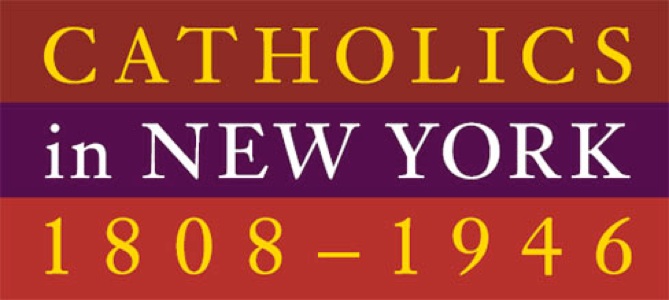As I have been researching Catholic New York of late, for the Old St. Patrick’s and St. Patrick’s shoots, I bought across this book online. It is a lovely book—truly museum quality. I have yet to read it, but should be doing so very soon. It never occurred to me that it might be paired with an actual exhibit! (duh)
Fortunately, I just found out that the exhibit exists at the Museum of the City of New York, and will be ending very soon! We’ll be driving to NYC on Tuesday to check it out. I hope it’s worth the 2 hour drive, but we’ll be stopping by some of our favorite NYC haunts while we’re there, including, hopefully, St. Patrick’s Cathedral.
I just finished reading the most fascinating and surprisingly well-written book about St. Patrick’s! I highly recommend it. A New World Rising: The Story of St. Patrick’s Cathedral was published not too long ago, which sets it apart from the few other books you can find about St. Patrick’s Cathedral. Surprisingly, there are not many—most of the ones I am reading are out of print—but I’m so glad that my Guardian Angel guided me toward reading this one first.
I say it’s surprisingly well-written because, well, I didn’t really expect the history of a Cathedral to be so riveting! I love being proven wrong about these silly expectations of mine. But, as a history, I suppose I expected it to be a dull recitation of facts and names, most of which I would never recognize. But the author, Thomas G. Young (who I really want to interview for the show) has a real knack for putting words together. I have to commend him, as I even was compelled to read the historical notes at the end of each chapter, and I found those interesting, too! And let’s be honest, not all authors are wordsmiths, but Young really deserves the title.
In my research on St. Elizabeth Ann Seton, for instance, I bought a few OP (our of print) books on Alibris. The first I picked up to read was written by Rev. Leonard Feeney, called An American Woman: The Story of Elizabeth Ann Seton. Before I even began to read, my mind started reeling… “Feeney… Feeney… why do I know that name?” My Guardian Angel is tremendously helpful, let me tell you. The book was quite old (pub’d in 1939), and my research reminded me that the author had had some of his own issues with scandal which made me a bit leery. I read on, but not for long. This author was much less organized with his thoughts—most of his tale of the saint’s life was frequently interrupted by his random digressions which had little to do with the saint and much more to do with his own random thoughts. As the purpose of my labor was to learn about Elizabeth Seton and not Leonard Feeney, I put the book down forever.
The next book I read was much better, although written in antiquated language that threw me, I must admit. Mrs. Seton: Foundress of the American Sisters of Charity ended up being a very good book, despite the confusing bits. It really made me realize how much our language has changed over the centuries. Born in 1776, Elizabeth Seton was alive when there were few standards for spelling and punctuation in our language. And the things they say! This book included a lot of the saint’s letters, and sometimes I felt as though I was reading a different language, or reading a letter full of inside jokes, and I was the clueless one. But it was very interesting. My contact at the shrine recommended another book, which I recently found on Alibris. I look forward to reading a more modern look at her life, but I do wish someone would publish a new book about her. She is such an amazing woman, and her life deserves to be discovered.


